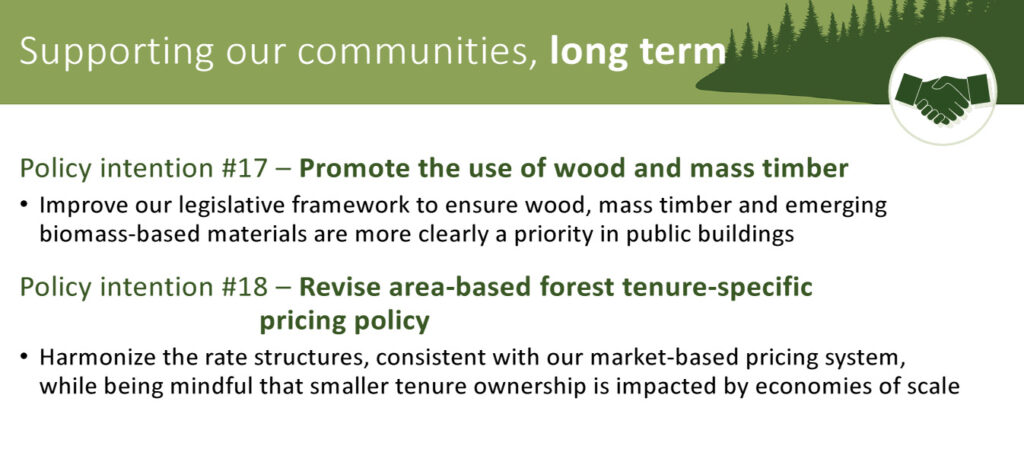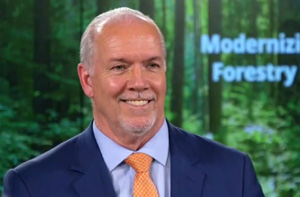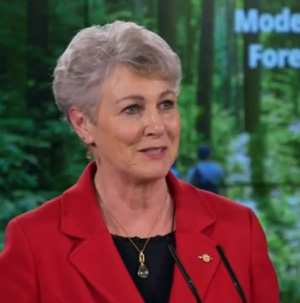Tuesday June 1, 2021 | VICTORIA, BC
by Jalen C Codrington | Island Social Trends | Editor: Mary P Brooke
Today the BC Government rolled out a new plan for the province’s forestry sector, calling it “more diverse, competitive, focused on sustainability, and puts people and communities first.”
Currently, five large companies hold roughly half of the forest tenures in the province.
The proposed changes to forest policy, as outlined in a new intentions paper, include a framework to redistribute these tenures across indigenous groups, forest communities, and small operators. There are 20 priorities outlined in the document.
Protecting jobs:
The province says protecting industry jobs is also a priority in the redistribution of tenures after recent job losses. In past years, the industry has faced reduced demand, high tariffs, high log costs, and epidemics caused by the mountain pine beetle and large wildfires. The government says there have been 1,620 permanent, 420 temporary, and 820 indefinite job losses in the forestry sector.
Use of Mass Timber:
BC wants to “strengthen the social contract” with the forestry industry, communities, and those are protecting the environment.
Part of that is providing better returns on forestry products (contributing to better economic security for towns and communities) and providing sustainable long-term jobs.
The use of mass timber as a priority in BC construction is also part of the plan.

New tenure opportunities will be created for new players. There will be compensation for lost harvesting rights, and flexibility when forest licences need to be reduced.
Annual Allowable Cut:
The province also plans to introduce a more flexible approach in determining the annual allowable cut (AAC), which is designated by the chief forester. “This [previous] method does not allow for government to consider a number of important elements in our changing environment,” says the report, “such as the unique pressures faced by small operators, or Indigenous or other local community interests.”
Old growth strategic review:
In addition, the proposal reaffirms commitments to implementing the 14 recommendations in the old-growth strategic review completed in 2020 by foresters Garry Merkel and Al Gorley. On Tuesday, Horgan said the NDP’s are committed to implementing all 14 recommendations by 2023, and restated that the government has already deferred the harvesting of 196,000 hectares of old growth – roughly 480 Stanley parks – while further work was put in place to protect hundreds of exceptionally large trees.
The province says there are currently 13.7 million hectares of old growth in British Columbia, and 10 million of those hectares are either protected or not considered economical to harvest. All in all, there are about 57 million hectares of forested land in BC.
In a statement, the BC Council of Forest Industries applauded the government’s announcement today, saying a collaboration with various stakeholders moving forward will help “sustain good jobs for British Columbians.”
Critics, however, say this new plan does little to address preservation of old-growth forests that are actively being logged, including those within TFL46, at the Fairy Creek Watershed.
When asked about the possibility of immediate old-growth deferrals at Fairy Creek, the premier said that he understands the passion for ancient trees and old-growth forests, and that consultation with First Nations is the “highest priority” of the government.
“If we were to arbitrarily put deferrals in place there [Fairy Creek],” said Horgan, “that would be a return to the colonialism that we have so graphically been brought to as a result of issues in Kamloops this week.”
First Nations approval:
All of Teal-Jones’ cutting permits have been approved by the Pacheedaht First Nation, upon whose traditional territory the tree farm license encompasses. In a statement signed by Pacheedaht Hereditary Chief Frank Queesto Jones and Chief Councillor Jeff Jones, with whom the NDP government has worked closely, the First Nation said, “We do not welcome or support unsolicited involvement or interference by others in our territory, including third-party activism.”
Despite this, not all indigenous voices are in agreement. Elder Bill Jones, who has been an active supporter of the Fairy Creek protests, has called the previous statement “a deliberate attempt to control Indigenous voices and leadership that do not accept exploitation of the land and dishonest representations of Pacheedaht peoples and territories.”
Sidestepping Fairy Creek:
When asked about the ongoing RCMP conflict within the Fairy Creek region, Horgan replied that the government does not direct law enforcement.
Teal-Jones, a private logging company, was granted an injunction by the BC Supreme Court in April, which the RCMP has been enforcing since May 17. So far, over 150 protesters have been arrested in the Fairy Creek region.
Favouring old growth protection:
Himself, Horgan is in support of protecting old growth forests. But he has a balancing act to achieve, as he outlined during the news conference.
“There will be new deferrals on old-growth,” Horgan said, “subject to consultation with the titleholders – Indigenous Peoples who have been on the territories of British Columbia for millennia.”
===== LINKS:





